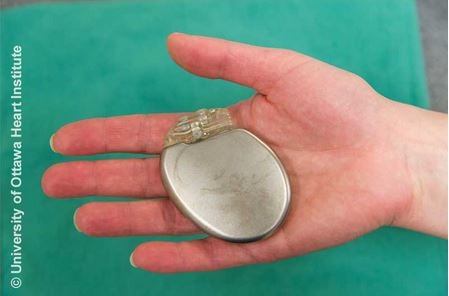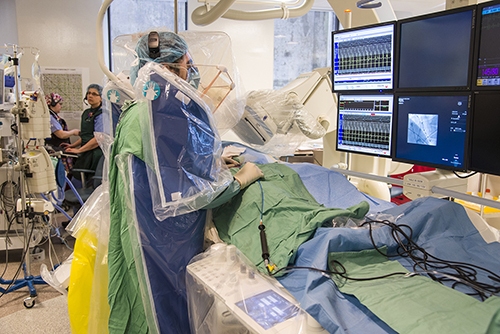Purpose

Ventricular arrhythmias are rapid heartbeats in the lower chambers of the heart. Two types of fast heart rhythm are ventricular tachycardia (VT) and ventricular fibrillation (VF). Both of these arrhythmias can be life threatening because they prevent the heart from keeping the blood circulating throughout your body.
The main purpose of an ICD is to regulate harmful heart rhythms and provide immediate intervention to restore a normal heart beat. An ICD may be also implanted in patients deemed at high risk for sudden cardiac death due to cardiomyopathy.
Every year, thousands of people in Canada receive an ICD. Most people who have ICD implants return to their normal active lives.
At the Heart Institute, ICD implant procedures are done by a cardiologist who specializes in the electrical system of the heart. This specialty is called Electrophysiology. There are several electrophysiology doctors working at the Heart Institute.
Description

- Before you go for your implant, the doctor will come and meet you in the Day Unit. This will be a good time to ask any questions you may have.
- Once you are in the Day Unit, the final preparations for your procedure will start. You will change into a hospital gown. You may have a small intravenous tube placed in your arm. The implant area will be clipped of hair and cleaned.
- You will be taken by stretcher to the Electrophysiology Lab for your procedure.
- Your chest area will be washed with a cold solution and sterile sheets will be placed over you.
- During your procedure, you will receive medications in your intravenous that will make you feel very relaxed. You might even fall into a light sleep.
- A local anesthetic will be administered to the area below your collarbone to numb the area where the ICD will be inserted.
- Once the anesthetic has taken effect, the doctor will make a small incision. The ICD leads will be threaded into your heart through a vein in your chest. You will not feel any pain, but you may feel some pressure as the veins are entered. The device is then put into place just under the skin.
- Once the procedure is finished, the incision will be closed with special stitches.
- After your procedure, you will be taken back to the Day Unit on a stretcher or bed. You may be hooked up to a heart monitor that will keep track of your heart rate and your blood pressure. Shortly after your procedure, you will go for a chest X-ray to check your ICD placement.
- Once you are feeling better, you will be able to go home.
Patient instructions
- Only one friend or relative will be able to sit with you while you are waiting because space is limited.
- You must have someone pick you up at the hospital and drive you home.

